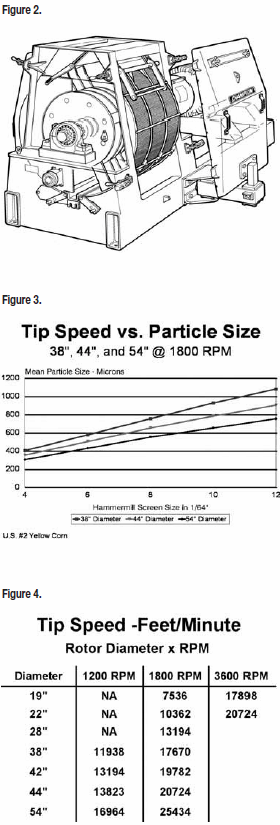High Speed Hammermills For Fine Grinding: Part 3 - Basic Operational Concepts, Tip Speed
Basic Operational Concepts

As noted, particle size reduction in a hammermill occurs as a result of the impact between a rapidly moving hammer and a relatively slow moving particle. The particle breaks and is accelerated towards the screen; depending on the particle size and angle of approach, it either passes through the screen or rebounds from the screen into the rapidly moving hammers again. As materials move through the grinding chamber they tend to approach hammer tip speed. Since reduction only occurs when a significant energy is transferred from the hammer to the particle (large difference in velocities), less grinding takes place as the particles approach full hammer tip speed (Figure 1).
While the basic operational concepts are the same for all hammermills, the actual operating conditions change rather dramatically depending on the materials being processed. Grains such as corn, wheat, and sorghum and various soft stocks like soybean meal tend to be quite friable and easy to grind. Fibrous, oily, or high moisture products like animal derived proteins and wheat bran are tough to grind and will require more energy to reduce. To achieve the best performance, the hammermill must be properly configured for the specific task of fine grinding for aquaculture feeds. The following discussion covers such factors as tip speeds, screen hole size, hammer patterns and position, horsepower ratios (to hammer and screen area), and air assist systems (Figure 2).
Tip Speed
Tip speed is simply a factor of mill diameter and motor RPM; D x RPM = TIP SPEED. Tip speed, in addition to screen size has a significant influence on finished particle sizing. High tip speeds (>100 M/Min) will always grind finer than lower tip speeds. Low tip speeds (<90 M/Min), on the other hand, produce a coarser, more uniform granulation with fewer fines. As a rule, smaller screen hole sizes should be used only with higher tip speeds, and larger screen hole sizes only with lower tip speeds (Figure 3).
Tip Speed - Fine Grinding and Tough to Grind Materials For fine grinding aquaculture feeds, a high tip speed is required. Normal tip speeds for fine grinding and fibrous materials are obtained on 44" (1.1M) diameter hammermills operating at 1800 RPM and 22" (0.55 M) diameter hammermills operating at 3,600 RPM or 28" hammermills operating at 3000 RPM and 54" hammermills operating at 1500 RPM would be about 110 M/Min Ft/Min). Recent developments in hammermill grinding have included the use of 54" diameter hammermills operating at 1800 RPM. This very high tip speed (>125 M/Min) is particularly well suited to fine grinding at high capacities and high efficiency. Because a larger screen (hole) sizes can be used while maintaining the fineness of the grind, operating costs are reduced as well. High tip speeds also help insure the hammers will not "rock" while the machine is operating with full motor loads, preventing excessive wear on the hammer holes and mounting pins (Figure 4).
High Speed Hammermills For Fine Grinding: Part 2 - Equipment Description, Basic Machine Characteristics
High Speed Hammermills For Fine Grinding: Part 4 - Hammers, Screens
High Speed Hammermills For Fine Grinding: Part 5 - Feeders, Air Assist
High Speed Hammermills For Fine Grinding: Part 6 - Other Considerations




